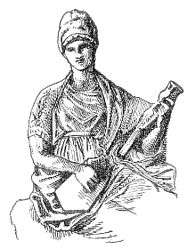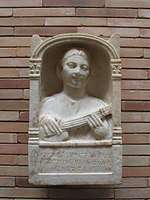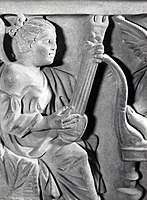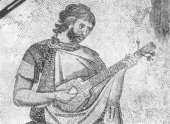Pandura
The pandura (Ancient Greek: πανδοῦρα, pandoura) or pandore, an ancient string instrument, belonged in the broad class of the lute and guitar instruments. Akkadians played similar instruments from the 3rd millennium BC. Ancient Greek artwork depicts such lutes from the 3rd or 4th century BC onward.[1]
 Modern lithograph of a bas relief from Mantineia (4th century BC), exhibited at National Archaeological Museum of Athens. The image shows a muse playing a pandoura, and the original is the oldest image of a pandoura currently known. | |
| Classification |
|
|---|---|
| Related instruments | |
| Look up pandura in Wiktionary, the free dictionary. |
Ancient Greece
The ancient Greek pandoura was a medium or long-necked lute with a small resonating chamber, used by the ancient Greeks. It commonly had three strings: such an instrument was also known as the trichordon (three-stringed) (τρίχορδον, McKinnon 1984:10). Its descendants still survive as the Greek tambouras and bouzouki,[2][3] the North African kuitra, the Eastern Mediterranean saz and the Balkan tamburica and remained popular also in the near east and eastern Europe, too, usually acquiring a third string in the course of time,[4] since the fourth century BCE.
Renato Meucci (1996) suggests that the some Italian Renaissance descendants of Pandura type were called chitarra italiana, mandore or mandola.
Roman
Information about Roman pandura-type instruments comes mainly from ancient Roman artwork. Under the Romans the pandura was modified: the long neck was preserved but was made wider to take four strings, and the body was either oval or slightly broader at the base, but without the inward curves of the pear-shaped instruments.[5] The word pandura was rare in classical Latin writers.[6]
Mesopotamia
Lute-class instruments were present in Mesopotamia since the Akkadian era, or the third millennium BCE.[7]
Eastern variations
There were at least two distinct varieties of pandura.[5] One type was pear-shaped, used in Assyria and Persia.[5] In this type the body had graceful inward curves which led up gradually from base to neck.[5] These curves changed at the bottom end off the instrument to a more sloping outline, an elongated triangle with the corners rounded off.[5] The oval type, a favourite instrument of the Egyptians, was also found in ancient Persia and among the Arabs of North Africa.[5]
Gallery
 Ancient Greek Tanagra figurine, 200 BC.
Ancient Greek Tanagra figurine, 200 BC.- Short lute-family instrument on a Hellenistic-style plaster sculpture made in Hadda, Afghanistan and now at the Guimet Museum in Paris. Estimated date 1st-2nd century AD.
 Memorial stele for a 16-year-old Roman woman, depicted playing a pandura-type instrument, date estimated 2nd century A.D. Unearthed in 1956 at the archeological site Emerita Augusta in Spain. Kept at the Museo Nacional de Arte Romano in Mérida, Spain.[8][9][10]
Memorial stele for a 16-year-old Roman woman, depicted playing a pandura-type instrument, date estimated 2nd century A.D. Unearthed in 1956 at the archeological site Emerita Augusta in Spain. Kept at the Museo Nacional de Arte Romano in Mérida, Spain.[8][9][10] Pandura-type instrument depicted on a Roman sarcophagus dated 3rd century AD.[11]
Pandura-type instrument depicted on a Roman sarcophagus dated 3rd century AD.[11] Roman or Byzantine pandoura from a 6th-century A.D. mosaic in the Great Palace of Constantinople. The instrument has three strings.[12]
Roman or Byzantine pandoura from a 6th-century A.D. mosaic in the Great Palace of Constantinople. The instrument has three strings.[12]
See also
References
Citations
- Lingas, Alexander (2006). "Instruments, Musical". In Wilson, Nigel Guy (ed.). Encyclopedia of Ancient Greece. Psychology Press. p. 385. ISBN 978-0-415-97334-2.
- "Ταμπουράς" [Tabouras], Museum Of Greek Popular Musical Instruments (in Greek), archived from the original on April 9, 2016
- Jeffreys, Elizabeth; Haldon, John; Cormack, Robin, eds. (2008), The Oxford Handbook of Byzantine Studies, Oxford: Oxford University Press, p. 928, ISBN 978-0-19925-246-6; Maliaras, Nikos (2007), Byzantina mousika organa [Byzantine musical instruments], Athens: Papagregoriou-Nakas, ISBN 978-9-60755-444-4 EPN 1023; and Digenis Akritas, Escorial version, vv. 826-827, ed. and transl. Elizabeth Jeffreys.
- Ammer, Christine (2004). The Facts on File Dictionary of Music (4th ed.). Infobase Publishing. p. 298. ISBN 978-1-4381-3009-5.
- "Pandura" in Encyclopædia Britannica, year 1911.
- Search for word pandura at "Classical Latin Texts", a website that is able to boast: "This website contains essentially all Latin literary texts written before A.D. 200, as well as some texts selected from later antiquity." Pandura is very rare as a word in classical Latin texts, but pandura-type instruments are not very rare in ancient Roman artwork. This raises the question: what then did the ancient Romans call it? Classical Latin cithara meant a lyre-type instrument at least sometimes, but sometimes it meant any plucked string musical instrument, and it seems very probable that the pandura was called by the name cithara in classical Latin at least sometimes. The classical Latin dictionary of Lewis and Short translates Classical Latin cithara as English "cithara, cithern, guitar, or lute". See Lewis, Charlton T.; Short, Charles (1879). "cithara". A Latin Dictionary; Founded on Andrews' edition of Freund's Latin dictionary. Oxford: Trustees of Tufts University. Retrieved 8 January 2018.
- Hassan, Scheherezade Qassim; Morris, R. Conway; Baily, John; During, Jean (2001). "Tanbūr". In Sadie, Stanley; Tyrrell, John (eds.). The New Grove Dictionary of Music and Musicians. XXV (2nd ed.). London: Macmillan. pp. 61–62.
- "Photograph of the museum information sign for the stele". Flickr. 25 September 2012. Retrieved 8 January 2018.
- Edmondson, Jonathan; Basarrate, Trinidad Nogales; Trillmich, Walter (2001). Imagen y memoria: Monumentos funerarios con retratos en la colonia Augusta Emerita (in Spanish). Real Academia de la Historia. p. 144. ISBN 978-84-89512-92-4.
- "Estela de Lutatia Lupata". Museo Nacional de Arte Romano. Retrieved 8 January 2018.
La joven LUTATIA toca un instrumento de cuerda, tipo "pandarium"... [translation: The young LUTATIA plays a stringed instrument, "pandarium" type]
- "Sarcophagus (1805,0703.132)". The British Museum. Retrieved 8 January 2018.
The sarcophagus is in The British Museum, which says it was uncovered near Rome and was probably made in Rome itself, and date-estimates it 3rd century AD.
- Brett, Gerard (1942). "The Mosaic of the Great Palace in Constantinople". The Journal of the Warburg and Courtauld Institutes. 5: photographic plate 9a and page 36. JSTOR 750447. Farmer, Henry George (1949). "An Early Greek Pandore". The Journal of the Royal Asiatic Society. 1 (2): 177–179. JSTOR 25222335.
The instrument is a three-stringed pandoura...
Bibliography
- McKinnon, J. W. (1984). "Pandoura". In Sadie, S. (ed.). The New Grove Dictionary of Music and Musicians. 3. London: Macmillan Press. p. 10.
External links
| Wikisource has the text of the 1911 Encyclopædia Britannica article Pandura. |